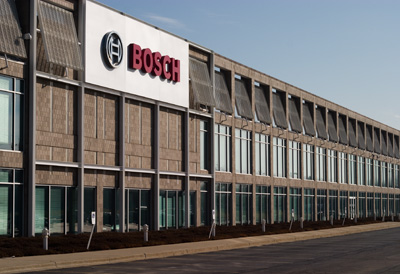In a selection of Chicago factory postcards, the Charles Bruning Company offers a good place to start. The company’s frequent moves provide a textbook example of industrial relocation common among firms throughout the metro area. The Bruning Company also provides a glimpse into a small segment of Chicago’s once-dominant printing industry.

The company’s history begins in lower Manhattan where Charles Bruning started the company in 1897 making blueprints. Only a year later, the company moved to Van Buren and Dearborn in Chicago. Fittingly, they moved around among in several locations in the Printer’s Row area, finally settling at 445 Plymouth Court. Branches of the company were opened throughout the country. The company diversified into manufacturing drafting supplies and copy machinery for small to mid-size printing operations. Later, most of its profits would be made manufacturing the paper for these machines.1

As with many other firms, expressway construction and urban renewal projects in the central area led to the need for movement to the outer reaches of the city. The Bruning Company’s factory at 445 Plymouth Court was in the path of construction for Congress Parkway, and they were forced to move. In 1941, Bruning built the factory depicted in the postcard at 4700 W. Montrose. Victor L. Charn was the architect of the Art Moderne structure; he designed several other factories in the same style, including the former Motorola factory on Augusta Boulevard.2


Charles Bruning also operated another factory only a block away in the Montrose Manufacturing District, at 4321 N. Knox. However, locations wouldn’t be making drafting supplies for long, as ground was broken in 1956 on a new factory in Mount Prospect, intended to consolidate all of the company’s Chicago operations. The company’s seemingly continual movement to the outer reaches of the metro area was not unique; many other firms and manufacturing concerns made similar moves, citing issues such as the need for more space and workforce availability. In fact, Oliver Bruning was quoted in 1960 about the move to Mount Prospect, “It has a rail siding and the labor market is good. We moved out of Chicago to get additional room. We were getting hemmed in by the city.” 3 The new plant opened in 1957 and was designed by A. Epstein and Sons, a prolific Chicago engineering/architectural firm. The complex was huge, with the nationwide offices of the company located in the building as well. 4


Left: A. Epstein
Time has been kind to the former Charles Bruning plant on Montrose, especially when compared to the alterations of the newer Mount Prospect plant. Unlike similar factories of its age, the Montrose Bruning factory remains quite intact. Many details visible on the postcard are still present. The entranceway remains strikingly original, sans the former Charles Bruning lettering. A loading dock has been added to the right of the entrance, but the ribbon windows remain intact, a rarity on structures of this type. Currently in use by an imports company, this excellent example of Art Moderne factory architecture remains well cared for and will hopefully be around for generations to come. As for the Charles Bruning Company itself? Merged with the Addressograph-Multigraph Corporation in 1963, it later became known as the Multigraphics division of AM International.5 At some point the Mount Prospect plant was closed, as it was later used by 3Com and currently Bosch. Unlike the intact plant on Montrose, the Mount Prospect plant (above right) has been heavily altered with a new facade, and retains very little of its original design.



